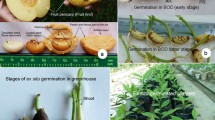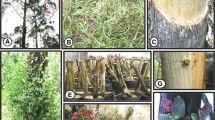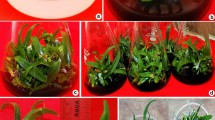Abstract
Spanish red cedar, Cedrela odorata L. (Meliaceae), is a valuable timber tree in tropical American forests. Existing demand for elite individuals endangers the conservation of interesting germplasm, prompting the development of efficient protocols for the establishment of orchards for tree breeding. Based on previous work regarding grafting adult individuals onto young rootstocks, superior trees from Calakmul Biosphere Reserve in Campeche, Mexico were employed as a source of explants for plant regeneration after successive rounds of grafting and micrografting onto juvenile rootstocks. The results showed that root length and appearance, internode distance, leaf length and number, and plant height values for trees derived from successive rounds of grafting and micrografting were similar to those obtained from juvenile trees derived from seeds, suggesting that developmental traits associated with reinvigoration were partially induced following the reported procedure. This protocol may be useful for the propagation of mature elite trees belonging to the Meliaceae family.





Similar content being viewed by others
References
Bonga JM (1987) Clonal propagation of mature trees: problems and possible solutions. In: Bonga JM, Durzan DJ (eds) Cell and tissue culture in forestry: general principles and biotechnology. Springer, Dordrecht, pp 249–271
Chen Y-T, Shen C-H, Lin W-D et al (2013) Small RNAs of Sequoia sempervirens during rejuvenation and phase change. Plant Biol 15:27–36. https://doi.org/10.1111/j.1438-8677.2012.00622.x
Chuck G, Connor DO (2010) Small RNAs going the distance during plant development. Curr Opin Plant Biol 40–45. https://doi.org/10.1016/j.pbi.2009.08.006
CONAFOR (2016) Manual para el Establecimiento de Unidades Productoras de Germoplasma Forestal, 1st edn. Guadalajara, Jalisco
da Costa Nunes E, de Castilho CV, Moreno FN, Viana AM (2002) In vitro culture of Cedrela fissilis Vellozo (Meliaceae). Plant Cell Tissue Organ Cult 70(3):259–268. https://doi.org/10.1023/A:1016509415222
Franclet A, Boulay M, Bekkaoui F et al (1987) Rejuvenation. In: Bonga JM, Durzan DJ (eds) Cell and tissue culture in forestry, 1st edn. Springer, Dordrecht, p 422
Huang L-C, Lius S, Huang B-L et al (1992) Rejuvenation of Sequoia sempervirens by repeated grafting of shoot tips onto juvenile rootstocks in vitro: model for phase reversal of trees. Plant Physiol 98:166–173. https://doi.org/10.1104/pp.98.1.166
Juarez-Gómez J (2013) Rejuvenecimiento en Cedro rojo (Cedrela odorata L.), mediante microinjertación e injertación. Centro de Investigación Científica de Yucatán AC
Liu H, Gao Y, Song X et al (2018) A novel rejuvenation approach to induce endohormones and improve rhizogenesis in mature Juglans tree. Plant Methods 14:13. https://doi.org/10.1186/s13007-018-0280-0
Lloyd G, McCown B (1980) Commercially-feasible micropropagation of mountain laurel, Kalmia latifolia, by use of shoot-tip culture. Commercially-feasible micropropagation of mountain laurel, Kalmia latifolia, by use of shoot-tip culture 30:421–427
Martínez E, Galindo Leal C (2002) La vegetación de Calakmul, Campeche, México: clasificación, descripción y distribución. Boletín la Soc Botánica México, pp 7–32
Molnar A, Melnyk CW, Bassett A, et al (2010) Small silencing RNAs in plants are mobile and direct epigenetic modification in recipient cells. Science (80-) 328:872–875. https://doi.org/10.1126/science.1187959
Moon HK, Park SY, Kim YW, Kim SH (2008) Somatic embryogenesis and plantlet production using rejuvenated tissues from serial grafting of a mature Kalopanax septemlobus tree. Vitro Cell Dev Biol Plant 44:119–127. https://doi.org/10.1007/s11627-008-9122-5
Murashige T, Skoog F (1962) A revised medium for rapid growth and bio assays with tobacco tissue cultures. Physiol Plant 15:473–497
Murashige T, Bitters WP, Rangan TS et al (1972) Technique of shoot apex grafting and its utilization towards recovering virus-free Citrus clones. HortScience 7:118–119
Nas MN, Read PE, Miller V, Rutter PA (2002) In vitro"rejuvenation" of woody species is temporary. In: XXVI international horticultural congress: biotechnology in horticultural crop improvement: achievements, opportunities and 625, pp 211–215
Opoku EM, Opuni-Frimpong E, Dompreh D (2018) Developing sustainable regeneration techniques for four African mahogany species: grafting methods for success and growth. New For. https://doi.org/10.1007/s11056-018-9677-x
Peña-Ramírez YJ, Juárez-Gómez J, Gómez-López L et al (2010) Multiple adventitious shoot formation in Spanish red cedar (Cedrela odorata L.) cultured in vitro using juvenile and mature tissues: an improved micropropagation protocol for a highly valuable tropical tree species. Vitro Cell Dev Biol Plant 46:149–160. https://doi.org/10.1007/s11627-010-9280-0
Peña-Ramírez YJ, García-Sheseña I, Hernández-Espinoza Á et al (2011) Induction of somatic embryogenesis and plant regeneration in the tropical timber tree Spanish red cedar [Cedrela odorata L. (Meliaceae)]. Plant Cell Tissue Organ Cult 105:203–209. https://doi.org/10.1007/s11240-010-9853-y
Pierik RLM (1990) Rejuvenation and micropropagation. In: Nijkamp HJJ, Plas LHW, Aartrijk J (eds) Progress in plant cellular and molecular biology. Springer, Amsterdam, pp 91–101
Read PE, Bavougian CM (2013) In vitro rejuvenation of woody species. In: Lambardi M, Ozudogru EA, Jain SM (eds) Protocols for micropropagation of selected economically-important horticultural plants. Humana Press, Totowa, pp 383–395
Secretaría de Economía (2016) Norma Mexicana NMX-AA-169-SCFI-2016: Establecimiento de unidades productoras y manejo de germoplasma forestal-especificaciones técnicas. Diario Oficial de la Federación 25 de agosto de 2016, Mexico
Smulders MJM, de Klerk GJ (2011) Epigenetics in plant tissue culture. Plant Growth Regul 63:137–146. https://doi.org/10.1007/s10725-010-9531-4
Solís-Guillén I, Chaires-Pacheco M, Juárez-Gómez J et al (2017) Development of an ideotype-based selection tool for native tropical tree breeding by smallholder planters in Mexico’s Maya Forest. Small Scale For 16:521–534. https://doi.org/10.1007/s11842-017-9368-z
Thorpe TA, Harry IS, Kumar PP (1991) Application of micropropagation to forestry. In: Debergh PC, Zimmerman RH (eds) Micropropagation: technology and application. Springer, Dordrecht, pp 311–336
Titon M, Xavier A, Otoni WC (2006) Clonal propagation of Eucalyptus grandis using the mini-cutting and micro-cutting techniques. Sci For 71:109–117
von Aderkas P, Bonga JM (2000) Influencing micropropagation and somatic embryogenesis in mature trees by manipulation of phase change, stress and culture environment. Tree Physiol 20:921–928. https://doi.org/10.1093/treephys/20.14.921
Wang J-W, Park MY, Wang L-J et al (2011) MiRNA control of vegetative phase change in trees. PLoS Genet 7:e1002012. https://doi.org/10.1371/journal.pgen.1002012
Wendling I, Trueman SJ, Xavier A (2014) Maturation and related aspects in clonal forestry—part II: reinvigoration, rejuvenation and juvenility maintenance. New For 45:473–486. https://doi.org/10.1007/s11056-014-9415-y
Acknowledgements
JJG is indebted to CONACYT for PhD Fellowship 354843. YPR thanks ECOSUR for research Grant 5103711808. Authors want to thank to Natalia Labrin-Sotomayor for statistical advice.
Author information
Authors and Affiliations
Corresponding author
Ethics declarations
Conflict of interest
The authors state that they do not have any conflicts of interest.
Additional information
Publisher's Note
Springer Nature remains neutral with regard to jurisdictional claims in published maps and institutional affiliations.
Electronic supplementary material
Below is the link to the electronic supplementary material.
Rights and permissions
About this article
Cite this article
Robert, M.L., Juárez-Gómez, J., Chaires-Pacheco, M. et al. Successive grafting confers juvenility traits to adult Spanish red cedar (Cedrela odorata Linnaeus): a tool for the rescue of selected materials. New Forests 51, 335–347 (2020). https://doi.org/10.1007/s11056-019-09736-7
Received:
Accepted:
Published:
Issue Date:
DOI: https://doi.org/10.1007/s11056-019-09736-7




